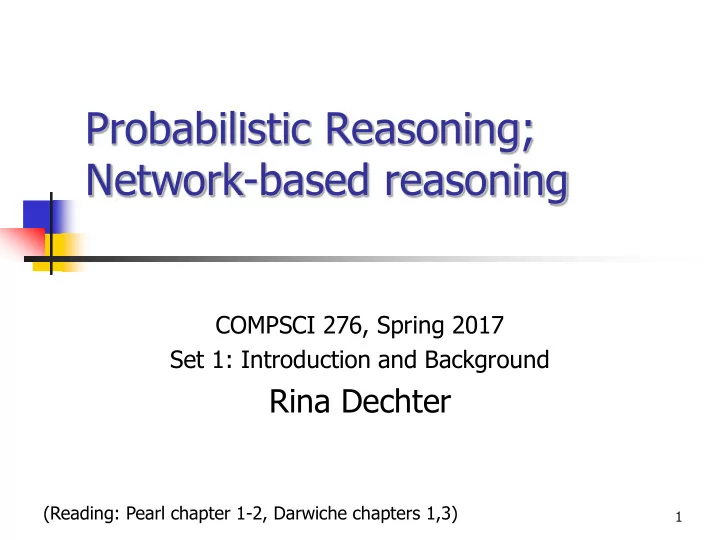

Probabilistic Reasoning; Network-based reasoning COMPSCI 276, Spring 2017 Set 1: Introduction and Background Rina Dechter (Reading: Pearl chapter 1-2, Darwiche chapters 1,3) 1
Example of Common Sense Reasoning Zebra on Pajama : (7:30 pm): I told Susannah: you have a nice pajama, but it was just a dress. Why jump to that conclusion?: 1. because time is night time. 2. certain designs look like pajama. Cars going out of a parking lot: You enter a parking lot which is quite full (UCI), you see a car coming : you think ah… now there is a space (vacated), OR… there is no space and this guy is looking and leaving to another parking lot. What other clues can we have? Robot gets out at a wrong level: A robot goes down the elevator. stops at 2 nd floor instead of ground floor. It steps out and should immediately recognize not being in the right level, and go back inside. Turing quotes If machines will not be allowed to be fallible they cannot be intelligent (Mathematicians are wrong from time to time so a machine should also be allowed) 2
Why/What/How Uncertainty? Why Uncertainty? Answer: It is abundant What formalism to use? Answer: Probability theory How to overcome exponential representation? Answer: Graphs, graphs, graphs … to capture irrelevance, independence 3
Class Description Instructor: Rina Dechter Days: Monday & Wednesday Time: 11:00 - 12:20 pm Class page: http://www.ics.uci.edu/~dechter/courses/ics-275b/spring-17/ 4
Outline Why/What/How… uncertainty? Basics of probability theory and modeling 5
Outline Why/What/How uncertainty? Basics of probability theory and modeling 6
Why Uncertainty? AI goal: to have a declarative, model-based, framework that allows computer system to reason. People reason with partial information Sources of uncertainty: Limitation in observing the world: e.g., a physician see symptoms and not exactly what goes in the body when he performs diagnosis. Observations are noisy (test results are inaccurate) Limitation in modeling the world, maybe the world is not deterministic. 7
Example of Common Sense Reasoning Explosive noise at UCI Parking in Cambridge The missing garage door Years to finish an undergrad degree in college The Ebola case Lots of abductive reasoning 8
Shooting at UCI Fire- shooting crackers what is the likelihood that there was a criminal activity if S1 called? What is the probability that someone will noise call the police? Vibhav Anat call call Stud-1 call Someone calls 9
What is the likelihood that P has Ebola Ebola in the US if he came from Africa? If his sister came from Africa? What is the probability P was in Africa given that he tested positive for Ebola? Visited Africa(p) Sister(P) visited Africa Ebola(sister(P)) Ebola( Mala Cancer(p) Ebola(p) Malaria(P) ria(P ) Symptoms-ebola Test-Ebola(p) Symptoms-malaria Test-malaria(p) 10
Why Uncertainty Summary of exceptions Birds fly, smoke means fire (cannot enumerate all exceptions. Why is it difficult? Exception combines in intricate ways e.g., we cannot tell from formulas how exceptions to rules interact: A C B C --------- A and B - C 11
Commonsense Reasoning(*) Example: My car is still parked where I left it this morning. If I turn the key of my car, the engine will turn on. If I start driving now, I will get home in thirty minutes. None of these statements is factual as each is qualied by a set of assumptions. We tend to make these assumptions, use them to derive certain conclusions (e.g., I will arrive home in thirty minutes if I head out of the ofice now), and then use these conclusions to justify some of our decisions (I will head home now). We stand ready to retract any of these assumptions if we observe something to the contrary (e.g., a major accident on the road home). 12
The Problem All men are mortal T All penguins are birds T True … propositions Socrates is a man Men are kind p1 Birds fly p2 Uncertain T looks like a penguin propositions Turn key – > car starts P_n Q: Does T fly? Logic?....but how we handle exceptions 13 P(Q)? Probability: astronomical
Managing Uncertainty Knowledge obtained from people is almost always loaded with uncertainty Most rules have exceptions which one cannot afford to enumerate Antecedent conditions are ambiguously defined or hard to satisfy precisely First-generation expert systems combined uncertainties according to simple and uniform principle Lead to unpredictable and counterintuitive results Early days: logicist, new-calculist, neo-probabilist 14
The Limits of Modularity Deductive reasoning: modularity and detachment P Q P Q P Q P K P K and P ------- ------ K Q Q ------ Q Plausible Reasoning: violation of locality Wet rain wet rain Wet Sprinkler and wet -------------- ---------------------------- rain rain? 15
Violation of Detachment Deductive reasoning Plausible reasoning P Q Wet rain K P Sprinkler wet K Sprinkler -------- -------------------- Q rain? 16
Probabilistic Modeling with Joint Distributions All frameworks for reasoning with uncertainty today are “intentional” model-based. All are based on the probability theory implying calculus and semantics. 17
Outline Why uncertainty? Basics of probability theory and modeling 18
24
25
Alpha and beta are events
Burglary is independent of Earthquake
Earthquake is independent of burglary
33
34
38
39
40
Example P(B,E,A,J,M)=? 41
42
43
44
45
Bayesian Networks: Representation P(S) BN Θ) Smoking (G, P(C|S) P(B|S) Bronchitis lung Cancer CPD: C B D=0 D=1 0 0 0.1 0.9 0 1 0.7 0.3 P(X|C,S) P(D|C,B) 1 0 0.8 0.2 X-ray 1 1 0.9 0.1 Dyspnoea P(S, C, B, X, D) = P(S) P(C|S) P(B|S) P(X|C,S) P(D|C,B) Conditional Independencies Efficient Representation 46
Recommend
More recommend